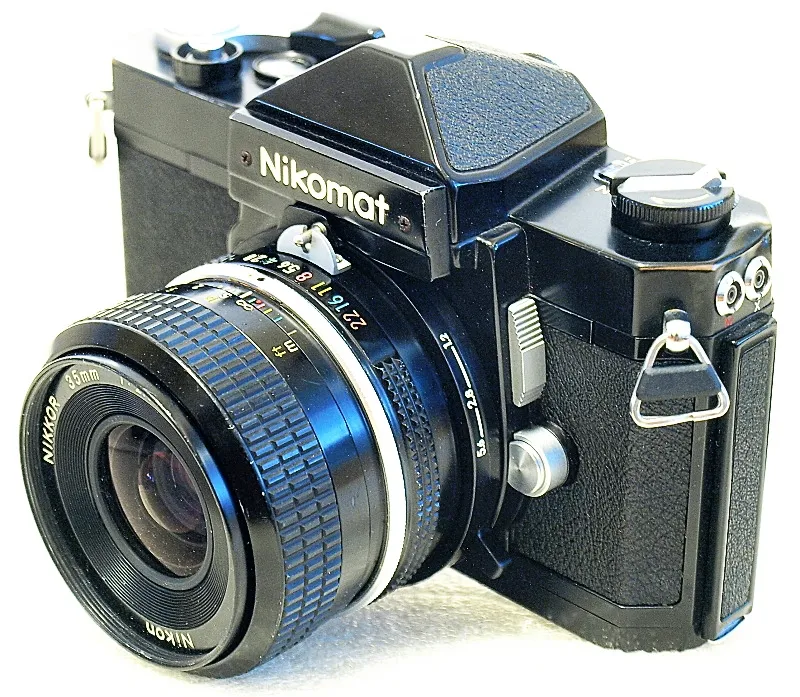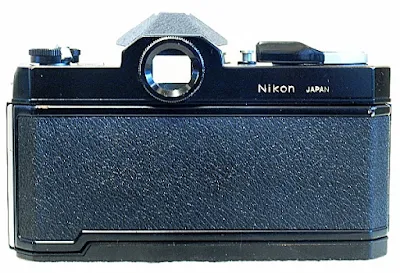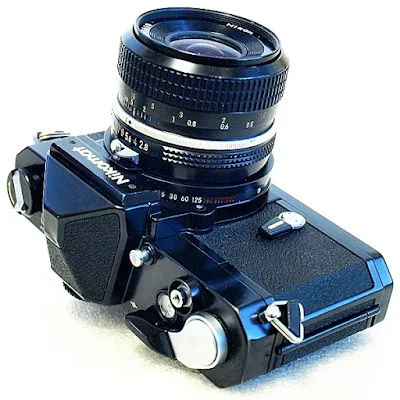The camera was an update to the original Nikomat/Nikkormat FT, which was manufactured from 1965 to 1967 and comes with a simplified lens mounting procedure for the 'rabbit-eared' Nikkor lenses.
Mechanically, the FTN is fitted with a vertical travel metal focal-plane shutter with a speed range from 1 to 1/1000 second and B, flash sync at 1/125 second, 'X' and 'M' flash terminals, and accepts film ISO speed range from 12 to 1600.
The FTN has a mirror-lockup and depth of field preview facility, a multiple-thread release cable socket, and a variable 8-second delay self-timer. For the update, the viewfinder over/underexposure metering display was added with '+' and '–' markers.
Introduction to the Nikon Nikkormat FTn (Video 1 of 2)
Nikon built the FTn as a complement to the professional-level F models. These durable camera introduced many Nikon users to the Nikon professional camera lin...
Metering is center-weighted TTL (Through the Lens) at full aperture with Auto-Nikkor lenses and stopped down when bellows focusing attachment, extension rings, or other accessories are used on the camera. Auto-Nikkor lenses without the coupling prong, for example, the Nikkor 200-600mm Telephoto Zoom, are also metered using the stop-down method. Reflex-Nikkor lenses are metered aperture-priority style.
Basic Camera Features
The claim to fame of the Nikomat/Nikkormat series may not be in its overwhelming response from users, but rather from select users who have a very high regard for the incredibly well-made and well-designed cameras. Nikomats/Nikkormats are often seen alongside professional-grade F series cameras and may, on occasion, replace them in the field.
The FTN is available both in black and chrome.
The front of the camera, as with the rest of the series, is all but plain, with the lens housing mount located slightly off-center to the right of the front plane, with the self-timer rocker switch to its left, and the lens release button on the right edge of the lens mount.
On the mount itself, on the top-right vertical is the mirror-lockup slider switch, and on the left is a small hump with a pointer dot to indicate the shutter speed setting. The shutter speed and film ISO speed dials are concentric on the camera lens mount itself.
On the top plane, from left to right, is the film rewind knob and pull-up film canister release, the meter window, which duplicates the TTL exposure reading, and the pentaprism trapezoid. To the right of the pentaprism are the depth of field preview button, the shutter release button, the film counter window, and the film forward crank.
On the back of the top plane level is the viewfinder eyepiece with a screw-in diopter correction lens. The rest of the camera back is occupied by the non-interchangeable hinged film, with its latch release mechanism located on the left shoulder of the film back, below the 2 flash sync sockets located above it.
On the bottom plate of the camera is the battery chamber with a half-turn lock cover, tripod socket, and film rewind release button.
The film box, with the film back release latch located on the left shoulder of the camera back, is a standard Nikon quick-load system with the film canister chamber, shutter window, sprocket gear, and the multi-slot take-up spool configuration laid from left to right.
Loading and Unloading the Film
The film roll is loaded into the camera by first inserting its canister into the leftmost chamber, pulling the film tab end right across the back, and inserting it into one of the inner slots of the take-up spool. The film is wound in the opposite direction of the film crank swing, with the emulsion side up.
Before closing the film back, ensure that the film is properly tensioned across the opening, and the perforations on the film edge are properly aligned with the sprocket gear. Do the standard 2-blank shots after closing the film back to forward the film to frame 1, and you are ready to go.
To rewind and unload, press the rewind release button on the camera baseplate and crank the film rewind lever clockwise until the film roll is fully rewound into the film canister. Release the camera's back cover, and remove the film roll for processing.
Viewfinder Readout
The FTN is fitted with a matte Fresnel field with a microprism spot viewfinder screen with 92% coverage. Metering is 60/40 center-weighted, biased towards the central area of the frame, and is switched on when the film advance lever is flipped out about 20° from the body of the camera.
The 'center-the-needle' exposure control system display is located on the lower right side of the viewfinder screen, and the shutter speed display is on a bar below the viewfinder screen.
The FTN was also offered with an option (made at purchase time or by replacement at factory service centers) of the brighter 'Type J' fixed viewfinder screen with a central 4mm microprism with a 12mm etched circle indicating the center-weighted metering area, or the 'Type A' with central 3 mm split image rangefinder plus 12 mm etched circle.
Mounting The Lens
Before mounting, the aperture opening of Ai lenses is first set to the F5.6 mark, and the coupling pin on the lens housing mount is rotated to the far right.
Insert the lens with the lens meter coupling prong aligned to the coupling pin, and rotate the lens to the left (anti-clockwise) to engage the mount.
Next, continue by turning the aperture ring all the way back and forth again to register the maximum aperture of the lens, indicated by a red index mark on the maximum-aperture scale dial located just below the coupling pin concentric on the lens housing mount.
Setting Shutter Speed and Film ISO Speed
The shutter speed on the FTN is set by using the left thumb (while holding the camera cupped in your left hand) on the finger slider of the ring, with the setting displayed on the shutter speed bar located at the bottom of the viewfinder screen.
If set manually, align the shutter speed number to the red dot on the top-left front of the lens mount housing.
The ISO speed setting is a slotted index pointer located on the lower part of the shutter speed ring and is adjusted by sliding the index pointer to the corresponding ISO number. This setting is normally checked or changed as and when you reload the camera with a new roll of film.
The Meter Window
The meter window, a small glass-covered opening located to the right and aft of the film rewind crank, replicates the exposure reading displayed in the viewfinder.
This gadget is a great assist, for example, when you have the camera mounted on a tripod for landscape or posed group shots, where you can do the final exposure setting without having to squint your eyes through the viewfinder.
DoF (Depth of Field) Preview
The FTN (just like the rest of the Nikomat/Nikkormat F series) is also fitted with a DoF (Depth of Field) preview, activated by a button located on the top plane of the camera.
Mirror Lockup
Mirror lockup, designed to facilitate the use of Nikkor Fisheye lenses, which can also be used for long-exposure photography, is activated by a slide switch located on the top-right vertical of the lens housing mount.
Self-Timer
The variable delay self-timer is activated by turning the timer lever in the anti-clockwise direction to the desired delay duration position. The delay, with the timer set to work with the mirror up, is actuated by the shutter release button.
Battery
The FTN was designed to be powered by the now-banned 1.3-volt Mercury Oxide battery.
Camera Body Weight
The Nikomat FTN camera's body weight is a hefty 765 grams without a battery.
Battery Chamber Cover
A unique design feature of the FT-series, not easily found on other camera makes and models, is the half-turn to open and lock the battery chamber cover. The cap is engraved with the letter O and an arced arrow to show the clockwise half-turn direction to unlock the cap, which pops out for easy replacement of the cell button battery.
Once a new battery is inserted, the cap is pushed in slightly and turned half-around in the anti-clockwise direction to lock. A misunderstanding of this method of use may lead to the cap breaking its lock stay, rotating freely, and falling off at specific spots of the turn, as seen on a couple of mismanaged units.
Series Iteration
The Nikomat/Nikkormat F series was initiated with the launch of the original FT and FS variant in 1965, upgraded to the FTN in 1967, the FT2 in 1975, and finally the Ai F-mount FT3 in 1977.
The series went electro-mechanical with the release of the EL in 1972, ELW in 1976, and EL2 in 1977, and was later rebadged as standard Nikons as FE, FM, EM, and subsequent models.
In Use
The Nikomat/Nikkormat F series cameras, designed on the philosophy of being cheaper and stripped-down alternatives to the pro-level F, not only come with a coupled internal light meter and F-mount lens system, but also with the highly accurate and reliable Copal square shutter.
This, and the fact that its production target was to maintain the legendary build quality that bears the hallmark of a Nikon, augurs well for a camera series that has been acknowledged as being a very strong and robust product with almost perfect mechanicals, well worth the investment it entails.
On the other hand, the camera is as silky smooth today as the day it came off the production line, simple, enjoyable, and with rock-solid reliability. These Nikomat/Nikkormats are commonly used by photojournalists, studio photographers, and as backup cameras by professionals.
Should You Get One?
Barring the choice of a workable battery solution, a definite yes!






















No comments:
Post a Comment